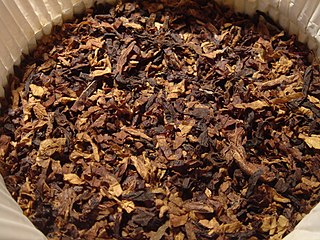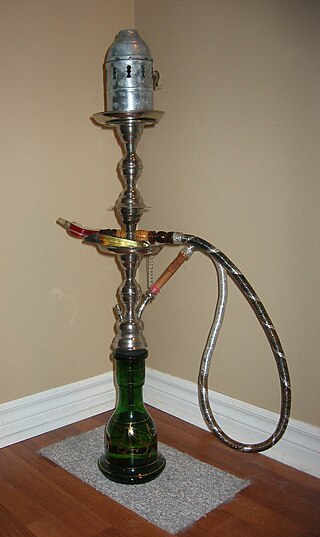
Imperial Brands plc is a British multinational tobacco company headquartered in London and Bristol, England. It is the world's fourth-largest international cigarette company measured by market share after Philip Morris International, British American Tobacco and Japan Tobacco and the world's largest producer of fine-cut tobacco and tobacco papers.

Lambert & Butler is a former English tobacco manufacturing company, established in 1834 in Clerkenwell, Central London, that operated as a private business until 1901 when it merged with other UK manufacturers to form the Imperial Tobacco Company. Apart from tobacco products L&B also released several cigarette card sets from the 1910s to the 1930s. They consisted of various topics including motor cars, locomotives, horsemanship, aviation, and association football.
Action on Smoking and Health (ASH) is the name of a number of autonomous pressure groups (charities) in the anglosphere that seek to publicize the risks associated with tobacco smoking and campaign for greater restrictions on use and on cigarette and tobacco sales.
Regal is a British brand of cigarettes. It is currently owned and manufactured by Imperial Tobacco.

A smoking ban in England, making it illegal to smoke in all enclosed workplaces in England, came into force on 1 July 2007 as a consequence of the Health Act 2006. Similar bans had already been introduced by the rest of the United Kingdom: in Scotland on 26 March 2006, Wales on 2 April 2007 and Northern Ireland on 30 April 2007. Plain tobacco packaging and a smoking ban in cars with passengers under 18 were introduced under Children and Families Act 2014.

An electronic cigarette (e-cigarette), or vape, is a device that simulates tobacco smoking. It consists of an atomizer, a power source such as a battery, and a container such as a cartridge or tank. Instead of smoke, the user inhales vapor. As such, using an e-cigarette is often called "vaping". The atomizer is a heating element that vaporizes a liquid solution called e-liquid, which quickly cools into an aerosol of tiny droplets, vapor and air. The vapor mainly comprises propylene glycol and/or glycerin, usually with nicotine and flavoring. Its exact composition varies, and depends on several things including user behavior.

Kyriazi Freres was a cigarette manufacturing company established in 1873 in Egypt. The company was founded by Ioannis Kyriazis, together with his brothers Efstathios and Epaminondas, although his other two brothers, George and Dimitris also played an active role in the company.
Embassy is a British brand of cigarettes, currently owned and manufactured by Imperial Tobacco.

Tobacco politics refers to the politics surrounding the use and distribution of tobacco, likewise with regulations.

The Egyptian cigarette industry, during the period between the 1880s and the end of the First World War, was a major export industry that influenced global fashion. It was notable as a rare example of the global periphery setting trends in the global center in a period when the predominant direction of cultural influence was the reverse, and also as one of the earliest producers of globally traded manufactured finished goods outside the West.

Tobacco has a long cultural, economic, and social impact on the United States. Tobacco cultivation in Jamestown, Virginia, in 1610 led to the expansion of British colonialism in the Southern United States. As the demand for Tobacco grew in Europe, further colonization in British America and Tobacco production saw a parallel increase. Tobacco use became normalized in American society and was heavily consumed before and after American independence.

The use of tobacco products in Egypt is widespread. It is estimated that approximately twenty percent of the population uses tobacco products daily. Cigarettes are the most common form of tobacco consumption in Egypt, with an estimated twenty billion cigarettes smoked annually in the country. After cigarettes, shisha water-pipes are the most common form of tobacco consumption.

SmokinginCanada is banned in indoor public spaces, public transit facilities and workplaces, by all territories and provinces, and by the federal government. As of 2010, legislation banning smoking within each of these jurisdictions is mostly consistent, despite the separate development of legislation by each jurisdiction. Notable variations between the jurisdictions include: whether, and in what circumstances ventilated smoking rooms are permitted; whether, and up to what distance away from a building is smoking banned outside of a building; and, whether smoking is banned in private vehicles occupied by children.
Smoking in Ireland is banned fully in the general workplace, enclosed public places, restaurants, bars, education facilities, healthcare facilities and public transport. However, it is permitted in designated hotel rooms and there is no ban in residential care, prisons and in outdoor areas. Public opinion is in favour of the bans on smoking which are in place in Ireland.

Regulation of electronic cigarettes varies across countries and states, ranging from no regulation to banning them entirely. As of 2015, around two thirds of major nations have regulated e-cigarettes in some way. A 2023 report by the World Health Organization (WHO) found that 34 countries had banned the sale of e-cigarettes.

Blu is an electronic cigarette brand, produced by Fontem Ventures and owned by Imperial Brands. The brand Blu sells various types of rechargeable and disposable e-cigarettes with a wide selection of flavored and unflavored liquids. Its products are available in many countries and each market offers different types of products suited to public demand and opportunities. The global headquarters of Blu is located in Amsterdam. Local offices are active around the world to service all markets which sell the brand.
The scientific community in the United States and Europe are primarily concerned with the possible effect of electronic cigarette use on public health. There is concern among public health experts that e-cigarettes could renormalize smoking, weaken measures to control tobacco, and serve as a gateway for smoking among youth. The public health community is divided over whether to support e-cigarettes, because their safety and efficacy for quitting smoking is unclear. Many in the public health community acknowledge the potential for their quitting smoking and decreasing harm benefits, but there remains a concern over their long-term safety and potential for a new era of users to get addicted to nicotine and then tobacco. There is concern among tobacco control academics and advocates that prevalent universal vaping "will bring its own distinct but as yet unknown health risks in the same way tobacco smoking did, as a result of chronic exposure", among other things.

A vape shop is a retail outlet specializing in the selling of vaping products, though shops selling derived psychoactive cannabis products have increased in the United States since the passage of the 2018 Farm Bill. There are also online vape shops. A vape shop offers a range of vaping products. The majority of vape shops do not sell vaping products that are from "Big Tobacco" companies. In 2013, online search engine searches on vape shops surpassed searches on e-cigarettes. Around a third of all sales of vaping products in one US state took place in vape shops. Big Tobacco believes the independent vape market is a threat to their interests.

Pod mods are a type of electronic cigarette used to vape nicotine through a mouthpiece connected to the body of the device by magnets. These devices are a newer generation of e-cigarettes that are often marketed to a younger crowd that do not wish to attract attention gained through regular e-cigarettes or traditional tobacco-burning cigarettes. Pod mods contain a disposable cartridge and coils.
Electronic cigarettes are marketed to smoking and non-smoking men, women, and children as being safer than cigarettes. In the 2010s, large tobacco businesses accelerated their marketing spending on vape products, similar to the strategies traditional cigarette companies used in the 1950s and 1960s.









































